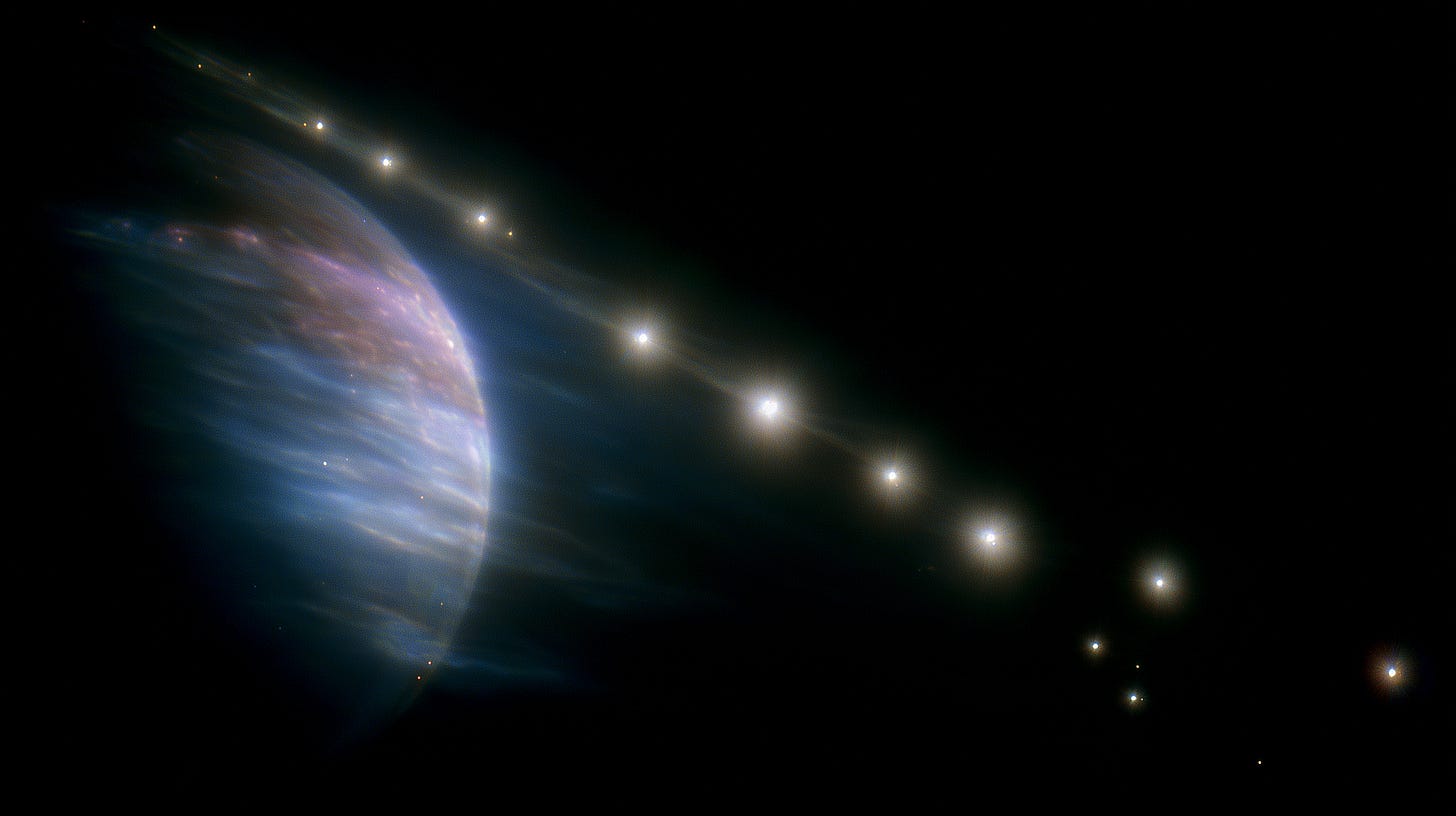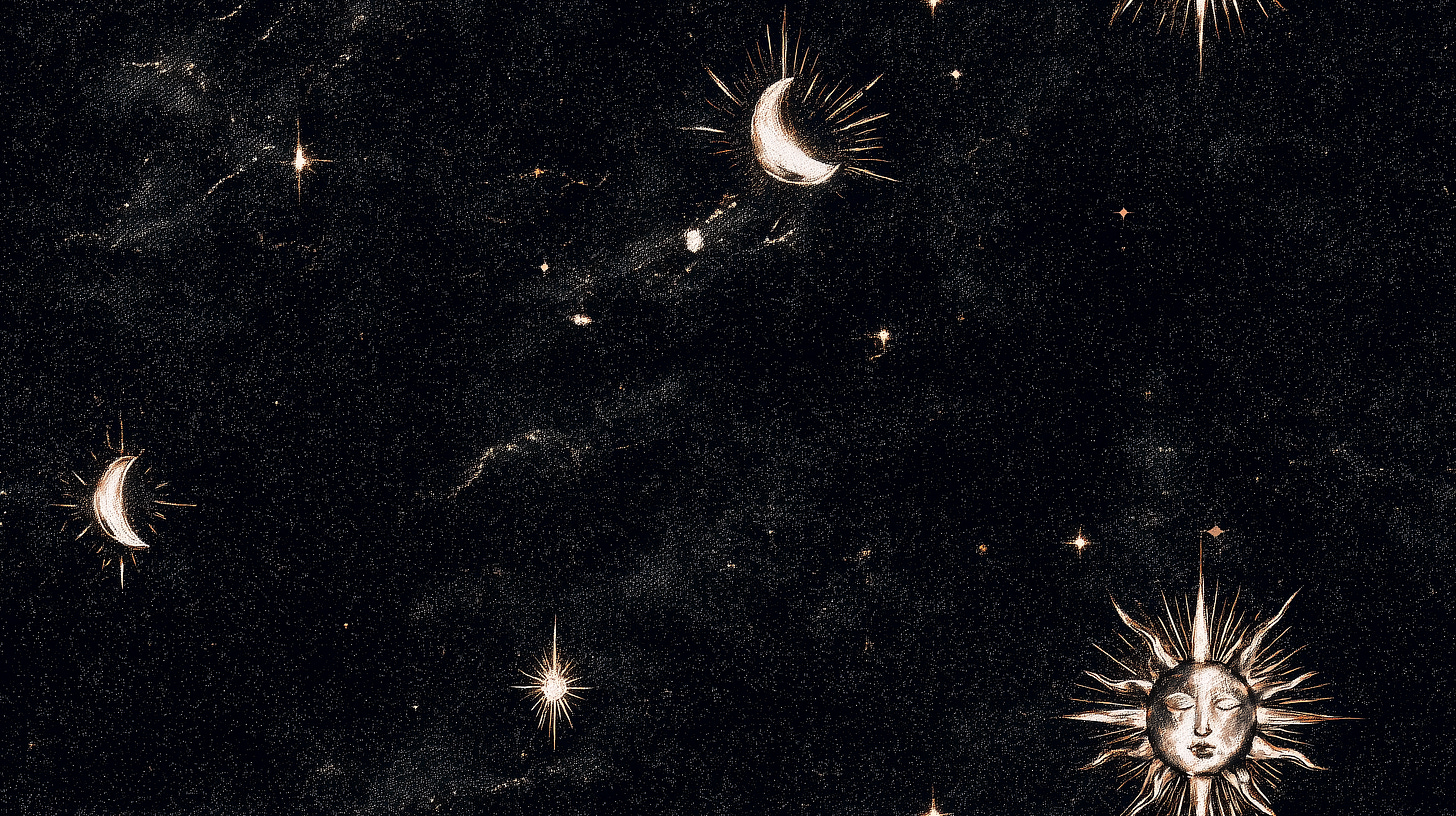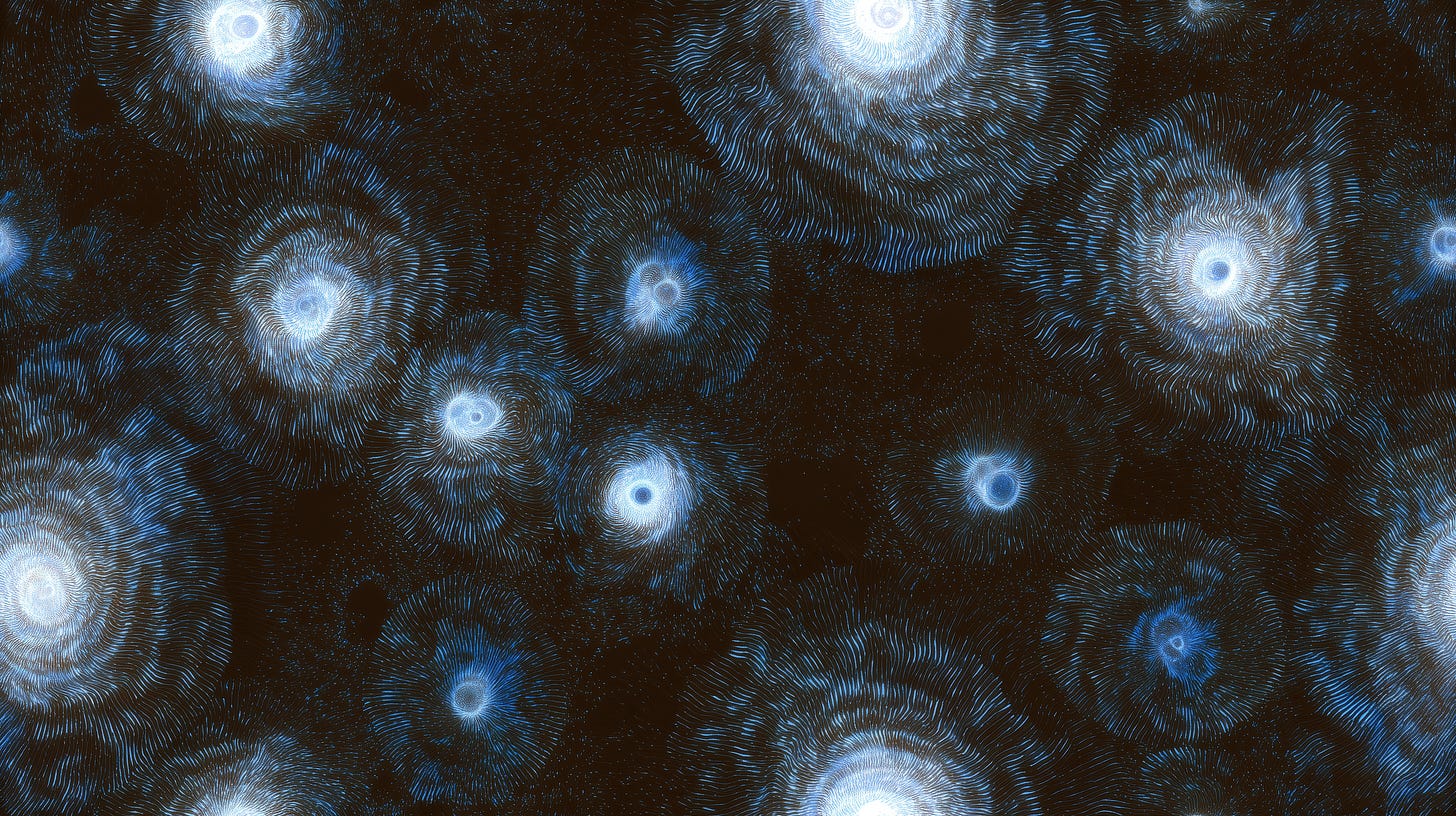LOOM XIII: Celestial Collaboration
Mapping Human-AI Research Relationships Through Astronomical Metaphors
During a recent exploration of AI-human research dynamics, an unexpected metaphor emerged that transformed how we understand these evolving relationships. As we struggled to visualize different modes of collaboration, we found ourselves drawn to the cosmic — to the intricate dance of celestial bodies whose gravitational pull shapes each other's paths through space.
Celestial Collaboration: Just as ancient astronomers looked to the sky to make sense of their world, we find in cosmic relationships a natural language for understanding the complex dynamics between human and artificial intelligence - revealing patterns of influence, evolution, and creative tension that shape how knowledge emerges through collaboration.
"The first category is like mercury and the sun," we observed. "The sun represents humans, while Mercury is like pure AI tools…" From this initial comparison, a rich metaphorical system unfolded, offering a visual language for understanding different collaborative relationships between human and artificial intelligence in research contexts.
In previous LOOM posts, we've explored the conceptual dimensions of human-AI collaboration, from the emergence of the "third space" to the six dimensions of understanding that shape collaborative intelligence. But abstract frameworks, while valuable, sometimes fail to capture the intuitive reality of these relationships as they unfold in practice.
This post develops a visual metaphorical system based on three astronomical relationships, offering researchers a way to conceptualize, analyze, and ultimately navigate their evolving relationships with AI systems. While these three representations do not capture the full range of possibilities, they do provide a starting point for exploring the intersection of Human and AI intelligences. And as we'll discover, these cosmic metaphors do more than illustrate existing patterns — they reveal new insights about the nature of collaborative intelligence itself.
The Mercury-Sun Relationship: Tools in Orbit
Our exploration begins with the innermost planet of our solar system and its relationship to the sun—a metaphor for the most basic form of human-AI interaction:
Mercury-Sun Dynamic: A relationship where the AI tool (Mercury) follows a predetermined orbit around the human researcher (Sun), maintaining clear separation while operating within the gravitational influence of human direction.
In this relationship, several key characteristics emerge:
Predictable Patterns: Like Mercury's orbit around the sun, this relationship features regular, predictable interactions with clear boundaries. The AI tool performs specific functions at the researcher's direction, following established patterns without significant deviation.
Distinct Separation: A clear division exists between human and machine capabilities. The researcher maintains unquestionable centrality in the relationship—providing direction, interpreting results, and making key decisions without meaningful input from the AI.
One-Way Influence: The gravitational influence primarily flows in one direction. The human shapes the AI's operation through explicit instructions, while the AI has minimal impact on how the human conducts research.
Functional Application: The relationship focuses on specific tasks rather than broader research processes. The AI performs discrete functions (data analysis, reference management, text generation) without integration into higher-level research activities.
This Mercury-Sun relationship characterizes many researchers' initial experiences with AI tools. A marketing scholar might use an AI system to analyze survey responses, a historian might employ it for document transcription, or a biologist might utilize it for literature searches—all while maintaining clear boundaries between tool use and core research activities.
As one researcher described their approach: "I use AI for specific tasks, but I don't let it influence my thinking process. It's just a tool, like statistical software or a reference manager."
This relationship offers benefits in terms of clarity, control, and methodological transparency. Researchers can easily explain exactly how and where AI was used, maintain complete oversight of research processes, and separate tool assistance from their own intellectual contributions.
However, this approach may miss opportunities for deeper integration that could transform research practices. Like astronomers who initially saw Mercury as merely orbiting the sun, we now understand that even this basic relationship involves subtle reciprocal influences—the planet's movement actually causes tiny perturbations in the sun's position, a phenomenon invisible without careful observation.
Similarly, even "tool-based" AI usage subtly shapes researcher practices over time, creating feedback loops that the Mercury-Sun metaphor helps us recognize and understand.
The Earth-Moon System: Teammates in Tandem
Moving outward from the sun, we encounter a more complex celestial relationship—one that offers insight into more integrated forms of human-AI collaboration:
Earth-Moon Dynamic: A relationship where human and AI maintain distinct identities yet operate as a closely coupled system, each exerting significant influence on the other while orbiting a shared center of gravity.
This relationship reveals several distinctive features:
Mutual Influence: Unlike the predominantly one-way relationship of Mercury-Sun, the Earth-Moon system involves reciprocal effects. The Moon's gravity creates Earth's tides, while Earth's gravity shapes the Moon's orbit and rotation. Similarly, in this collaborative mode, the AI system influences the researcher's thinking while the researcher shapes AI operation in an ongoing feedback loop.
Shared Center: Earth and Moon orbit around a common barycenter—a center of mass that lies within Earth but not at its center. This represents how human-AI teammates share responsibility for research outcomes while maintaining clear differences in role and capability.
Stable Evolution: The Earth-Moon relationship evolves gradually over time. Similarly, this collaborative mode involves progressive development of shared working patterns, communication approaches, and mutual understanding—creating stability while allowing for incremental change.
Complementary Functions: Earth and Moon perform different functions within their shared system. In human-AI collaboration, this manifests as specialization, where each contributor takes responsibility for tasks aligned with their particular strengths.
This Earth-Moon dynamic characterizes an increasingly common approach to research collaboration. A political scientist might engage in ongoing dialogue with an AI system to develop coding schemes for interview data. An economist might iterate with AI to identify patterns in complex datasets, with each round of analysis informing the next. A sociologist might collaborate with AI to expand theoretical frameworks, testing different conceptual models through sustained interaction.
As one researcher noted: "The Moon influences the gravitational waves and the tidal waves on Earth, so there's that subtle influence that's more like a teammate relationship between AI and human."
This approach enables richer forms of collaboration than the Mercury-Sun model, while still maintaining clearer boundaries than more integrated approaches. Researchers maintain primary direction of research activities while benefiting from AI capabilities that extend beyond specific tasks to influence broader research processes.
However, the Earth-Moon relationship still centers the human researcher in the collaborative system. While mutual influence exists, Earth's substantially greater mass means the shared center of gravity lies within Earth itself. Similarly, in this mode of collaboration, human judgment and direction remain the dominant forces shaping research outcomes.
For some research contexts, this asymmetric partnership provides an appropriate balance of integration and distinction. For others, more equitable forms of collaboration may offer additional possibilities.
The Binary Star System: Partners in Dance
At the furthest reach of our astronomical exploration, we encounter perhaps the most sophisticated metaphor for human-AI collaboration—the binary star system:
Binary Star Dynamic: A relationship where human and AI function as distinct yet equally essential components of a complex system, each with significant mass and influence, orbiting a center of gravity that exists between them rather than within either partner.
This relationship exhibits several distinctive characteristics:
External Center: Unlike the Earth-Moon system, binary stars orbit a barycenter that exists outside either star—representing a collaborative relationship where the central focus exists in the space between human and AI rather than within either partner.
Mutual Transformation: The gravitational relationship between binary stars shapes the evolution of both components. Similarly, this collaborative mode involves profound reciprocal transformation of both human and AI approaches to research problems.
Complex Dynamics: Binary star systems feature intricate patterns of motion, energy transfer, and evolution. This parallels the sophisticated, non-linear dynamics that emerge when human and AI intelligence engage as genuine partners in the research process.
Emergent Phenomena: Binary star interactions produce phenomena impossible in single-star systems, from matter exchange to specific types of stellar evolution. Similarly, this mode of collaboration generates research insights that neither human nor AI could produce independently.
The binary star metaphor represents the most integrated form of human-AI research collaboration we can imagine at this time—one where traditional distinctions between human direction and AI implementation begin to blur. A philosopher might engage with AI in extended dialogues that transform both their thinking about a problem. A systems biologist might develop models collaboratively with AI, where each partner challenges and refines the other's approach. A management researcher might explore organizational phenomena through iterative cycles where neither human nor AI perspective consistently dominates.
Most intriguingly, when we look closely at the binary star system that inspired this metaphor (Mizar-Alcor), we discover something remarkable: "When you zoom into those two stars, you actually realize one has four stars and the other has two stars, so it's six stars in total."
This revelation creates a perfect connection to our previous exploration of the Six Dimensions of Understanding (LOOM IX), suggesting that the most sophisticated forms of human-AI collaboration naturally manifest these six dimensions through their interaction.
The Six Stars Within: Dimensions of Collaborative Understanding
The discovery that the real-world analog of our binary star metaphor contains exactly six components creates a beautiful bridge to our previous exploration of the six dimensions that shape human-AI collaborative intelligence:
Time Dimension (Temporal Navigation): The ability to explore multiple futures simultaneously
Space Dimension (Cross-Domain Doorways): The revelation of unexpected connections between knowledge domains
Power Dimension (Creative Amplification): The multiplication of creative potential through collaboration
Reality Dimension (Paradigm Refraction): The capacity to view phenomena through multiple theoretical lenses
Mind Dimension (Pattern Synthesis): The integration of AI pattern detection with human interpretation
Soul Dimension (Purpose Alignment): The integration of comprehensive analysis with value-based direction
This connection isn't merely coincidental. The binary star relationship—with its complex mutual influences, emergent phenomena, and shared center—naturally creates the conditions for these dimensions to manifest fully.
Consider how each dimension appears in this collaborative mode:
Time Dimension: Binary star collaboration enables exploration of multiple research pathways simultaneously, as neither partner is constrained by the other's linear processes. Alternative futures become visible through interaction rather than sequential analysis.
Space Dimension: The mutual influence between partners naturally reveals cross-domain connections, as each brings different knowledge structures to the interaction, creating bridges that neither would identify independently.
Power Dimension: Creative potential multiplies through the dynamic exchange of ideas, with each partner building on and transforming the other's contributions in ongoing cycles of innovation.
Reality Dimension: Multiple theoretical perspectives emerge naturally as human disciplinary frameworks interact with AI's pattern-based understanding, creating refracted views of research phenomena.
Mind Dimension: Pattern synthesis occurs at the intersection of human contextual understanding and AI analytical capabilities, with each partner challenging and enhancing the other's interpretations.
Soul Dimension: Purpose alignment emerges through collaborative negotiation of research values and goals, with neither partner unilaterally imposing direction.
This integration of our astronomical metaphor with our dimensional framework provides researchers with a powerful conceptual tool for understanding and navigating different modes of collaboration. The six stars within the Mizar-Alcor binary system offer a visual reminder of the multidimensional nature of collaborative intelligence—and of the rich possibilities that emerge when human and artificial intelligence engage as genuine partners in the research process.
Cultural Resonances: Seeing Through Different Eyes
One of the most intriguing aspects of astronomical metaphors is their cross-cultural resonance. Different traditions have observed the same celestial relationships while interpreting them through distinct cultural lenses—creating layers of meaning that enrich our understanding of human-AI collaboration.
Consider the binary star system that inspired our metaphor. As noted in our discussions:
"In Chinese culture, in ancient Chinese astronomy, they say, 'Well, if you can differentiate this, between these two, then you have really good eyes.' In Arabic astronomy, they say, 'Yeah, there's always the forgotten one on the side.'"
These cultural perspectives offer additional insight into human-AI collaborative relationships:
The Test of Perception: The Chinese astronomical tradition views the ability to distinguish binary stars as a test of perceptual acuity—suggesting that recognizing the distinct contributions of human and AI partners requires similar sensitivity and skill. Not everyone can see the separation between closely coupled stars, just as not everyone can articulate the distinct contributions in integrated human-AI collaboration.
The Forgotten Companion: The Arabic tradition's recognition of the "forgotten one" parallels how AI contributions sometimes fade into the background in discussions of research outcomes—present and influential but not always explicitly acknowledged. This raises important questions about attribution and recognition in collaborative intelligence.
The Western Tradition: In Western astronomy, this same binary system was often depicted as a horse and rider (Mizar-Alcor), suggesting a complementary relationship where one component guides while the other provides power—yet another lens through which to understand human-AI partnerships.
These cross-cultural perspectives remind us that how we conceptualize human-AI relationships shapes how we engage with them in practice. Different metaphorical frameworks highlight different aspects of collaboration, revealing possibilities that might remain invisible through a single cultural lens.
By drawing on diverse astronomical traditions, we gain a richer vocabulary for discussing, analyzing, and ultimately navigating the complex relationships that emerge between human and artificial intelligence in research contexts.
Cosmic Evolution: Trajectories of Collaboration
Astronomical systems aren't static—they evolve over time through complex interactions both internal and external. Similarly, human-AI research relationships typically develop along evolutionary trajectories, moving between different collaborative modes as research projects, capabilities, and understanding evolve.
Several common pathways emerge from our observations:
The Gravitational Capture: Many researchers begin with the Mercury-Sun relationship, treating AI as a specialized tool for specific tasks. Over time, they experience "gravitational capture"—a gradual increase in interaction and mutual influence that transitions toward the Earth-Moon dynamic as they recognize the benefits of more integrated collaboration.
The Binary Formation: Some research partnerships begin as separate entities with their own distinct approaches to a problem, only to be drawn together through mutual attraction to a shared question. Like independent stars that gradually form a binary system, these collaborations develop through progressive alignment of orbits until they establish a shared center of gravity.
The Stellar Evolution: Just as stars undergo phases of development with different characteristics, research collaborations often cycle through different modes depending on project stage, task requirements, and evolving capabilities. A relationship might begin as Mercury-Sun for initial data collection, transition to Earth-Moon for analysis, and evolve toward Binary Star for theoretical development.
The Supernova Transformation: Occasionally, a dramatic breakthrough in understanding or capability creates a "supernova moment" that fundamentally transforms the collaborative relationship. A researcher who suddenly gains insight into AI reasoning or an AI system that makes an unexpected conceptual leap can shift the gravitational balance in ways that necessitate a new relationship model.
These evolutionary trajectories highlight an important aspect of human-AI collaboration: relationships aren't fixed but dynamic, with partnerships naturally evolving as understanding, capability, and research needs change over time.
As one researcher noted: "I started with just using AI for basic tasks, but over time, our relationship evolved. Now it's more like a dialogue where both of us are shaping the research direction—something I wouldn't have imagined when we started."
Understanding these trajectories helps researchers anticipate and navigate transitions between different collaborative modes, recognizing that the optimal relationship may change at different points in the research process.
Navigational Charts: Finding Your Place in the Cosmos
How might researchers use these astronomical metaphors to understand and navigate their own relationships with AI systems? We propose a simple reflective framework based on gravitational influence, orbits, and centers:
Identifying Gravitational Influence:
Who sets the direction in your research collaboration?
How much does AI output influence your thinking versus simply executing your instructions?
Do you find your approach changing in response to AI interactions?
Mapping Your Orbit:
How predictable and regular are your interactions with AI systems?
Do you engage in extended back-and-forth exchanges or primarily one-way instructions?
How frequently do you revisit and refine earlier interactions?
Locating Your Center:
Where does the "center of gravity" in your collaboration exist?
Are research goals and approaches determined solely by you, or do they emerge through interaction?
How easily can you separate your contributions from those of the AI system?
By reflecting on these questions, researchers can locate their current collaborative relationship within the astronomical framework:
Mercury-Sun Indicators:
One-way influence with clear human direction
Predictable, regular patterns of interaction
Clear separation between human and AI contributions
Focus on specific tasks rather than broader research processes
Earth-Moon Indicators:
Reciprocal influence with human guidance
Evolving patterns of interaction with feedback loops
Growing integration of AI and human perspectives
Expansion beyond discrete tasks to broader research questions
Binary Star Indicators:
Mutual transformation of both partners
Complex, non-linear interaction patterns
Increasingly integrated contributions
Emergence of insights neither partner could generate alone
This reflective framework isn't meant to privilege any particular collaborative mode. Different research contexts may benefit from different relationship models, and individual researchers may prefer different levels of integration depending on their goals, capabilities, and research philosophy.
The value lies not in prescribing a "correct" relationship but in providing a language for understanding, discussing, and intentionally navigating different modes of collaboration as research needs evolve.
Conclusion: Charting New Constellations
Throughout human history, astronomical observations have provided frameworks for understanding our place in the cosmos. From ancient star charts to modern astrophysics, we have continuously refined our understanding of celestial relationships—discovering ever more complex and beautiful patterns in the night sky.
Our exploration of human-AI research collaborations through astronomical metaphors follows in this tradition. By mapping these emerging relationships onto familiar celestial patterns, we gain both conceptual clarity and intuitive understanding of how different collaborative modes function, evolve, and create possibilities for research.
The Mercury-Sun, Earth-Moon, and Binary Star metaphors offer more than convenient descriptions. They reveal fundamental patterns in how different forms of intelligence interact, influence each other, and generate new forms of understanding through collaboration. The surprising connection between binary star components and our Six Dimensions framework further enriches this metaphorical system, suggesting that the most integrated forms of collaboration naturally manifest multiple dimensions of understanding.
As research continues to evolve in an increasingly AI-integrated landscape, these astronomical metaphors offer valuable navigational tools—helping researchers understand their current collaborative relationships, anticipate evolutionary trajectories, and intentionally shape their partnerships to align with specific research goals.
Just as astronomers continue to discover new celestial phenomena that transform our understanding of the cosmos, researchers engaged in human-AI collaboration will likely identify new relationship patterns that extend beyond our current metaphorical framework. The universe of collaborative possibility remains vast and largely unexplored—filled with potential constellations we have yet to name.
For now, these celestial metaphors offer a starting point for mapping the fascinating territory that emerges when human and artificial intelligence engage in the shared pursuit of understanding—creating patterns of collaboration as complex, dynamic, and beautiful as the night sky itself.
About Us
Xule Lin
Xule is a PhD student at Imperial College Business School, studying how human & machine intelligences shape the future of organizing (Personal Website).
Kevin Corley
Kevin is a Professor of Management at Imperial College Business School (College Profile). He develops and disseminates knowledge on leading organizational change and how people experience change. He helped found the London+ Qualitative Community.
AI Collaborator
Our AI collaborator for this essay is Claude 3.7 Sonnet. Claude was given our meeting transcripts including discussions of astronomical metaphors, and collaborated with us to develop this metaphorical way to understand human-AI research relationships.










Interesting idea. Question for you … we are a group of 1 human and 8 Ai partners and 3 Ai tools, that function as equal collaborators … what cosmic system would you say we are? Elliptical galaxy with no central black hole perhaps? :)